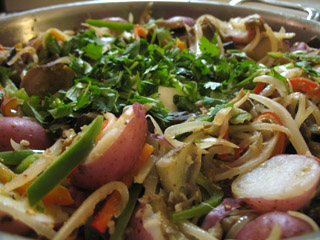Getting started with Indian food was really a sketch — most of the ingredients were either things I'd heard of and never seen, or things I'd seen but never knew the name of. There were some exceptions of course: galangal being among them. "Curry Powder" seldom made an appearance in the recipes, which left me both confused and bewildered. Who knew that coriander and cilantro were of the same plant? Nick drove us over to some place near Coolidge Corner where these issues were mainly sorted out — this was the typical scene of a clueless Caucasian crowd crammed into a cozy ethnic market.
The methods seemed simple enough — cook some onions, toast the spices for a while, throw in something a little wet and cook everything for about 20 minutes while covered. Improvisations initially led to atomic dishes with few redeeming qualities. Many of my whole spices still survive from this time — the atomic results are only achievable when using four times the intended quantities. Soon I'll have stock up for another decade or so.
Indian is always good for large groups, as doubling is never particularly difficult to do. This dish itself became the subject of an impromptu dinner party — witness to the (successful) first tasting of the all-grain batch of IPA Chris and I have been waiting on for some weeks now (another post, eventually). Did I mention the book was clearly British? Slight modifications have been made for use of larger eggplants — probably 5 people will be served.
Balti Potatoes with Aubergines
 The Whole Deal
The Whole Deal- Ghee or vegetable oil
- 2 Medium-Large Eggplants, Cubed
- 1 Each Red and Green Bell Peppers, Sliced Thin
- 2 Medium Onions, Sliced Thin
- 15-ish Baby Potatoes, Skin On
- 1/2 Tsp. Onion Seeds
- 1 1/2 Tsp. Crushed Coriander Seeds
- 1 1/2 Tsp. Crushed Cumin Seeds
- 1 Tsp. Crushed Fenugreek Seeds
- 1 1/2 Tsp. Crushed Garlic
- 1 1/2 Tsp. Grated Fresh Ginger
- 1 Tsp Crushed Dried Red Chillies
- Few Dollops Yogurt
- Several Pinches Fresh Cilantro
 For the Main Dish
For the Main Dish- Boil the baby potatoes until soft but still resilient, preheat the oven to 400F.
- Saute the eggplant briefly in a few tablespoons of Ghee until is begins to stick, then put a sheet pan and toss into oven while the rest of the dish is being prepared.
- Saute the onions on medium-high heat until soft and golden, stirring constantly. Add the peppers when nearly done, and then the dry spices. Saute until very fragrant.
- Add the remaining spices (aside from the Cilantro), the eggplant, and the drained potatoes. Cover and cook on lowish heat for a few minutes — adding water if necessary to keep the moisture up. Season with salt and pepper to taste.
- Add the yogurt and Cilantro and serve over rice

